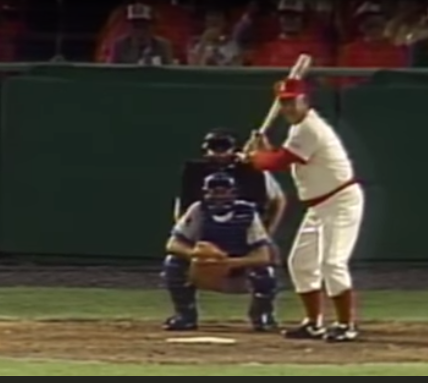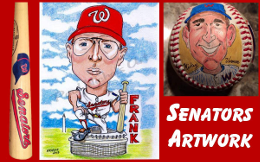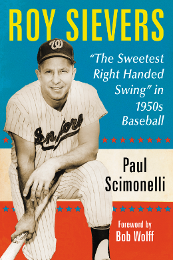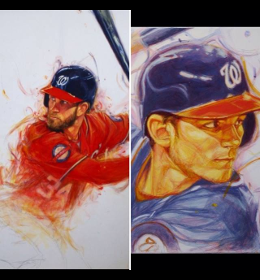By Jeff Stuart
“Don’t it always seem to go that you don’t know what you got ‘til it’s gone.”
After the Senators final game on Sept 30, 1971, there was no home team. But there were 17 exhibition professional baseball games played at RFK Stadium between then and April 2005, when the former Montreal Expos moved to Washington. Most were far better attended than most Senators games.
For the first two the stadium was in the familiar baseball alignment with the rotating section of seats Nationals fans love to make bounce positioned along the third base line. Both were for charity.
THE PADRES ARE COMING?
On May 22, 1972, the Pittsburgh Pirates played the .Baltimore Orioles in what was billed as the “8th game of the 1971 World Series.” The Orioles won, 5-2, scoring 3 times in the bottom of the ninth. Roberto Clemente, the most valuable player in that Series, went hitless in two at bats. Willie Stargell homered. For the Orioles, Paul Blair singled home two runs. Rightfielder Merv Rettenmund doubled in the ninth. The official paid attendance was 30,112. But the headline in the Washington Post the next day said,”38,445 See Orioles Down Pirates at RFK” A few former Nats’ fans had already trekked to Baltimore to see the “return” of the Senators in the form of the Texas Rangers a few weeks earlier. So the Orioles were marginally the home team. The game was a Children’s Hospital Benefit. Mayor Washington, seated alongside Commissioner Bowie Kuhn, American League President Joe Cronin and National League President Chub Feeney, led the crowd in chanting, “We want a team,” during the 7th inning stretch. The stadium was gleaming. The field was immaculate. “I think even the ground crew was out to prove something,” said Joe Danzanky, CEO of Giant Food, who was working on a deal to bring the San Diego Padres to Washington. Padres’ general manager Peter Bavasi had already been to Washington to exploring the possibilities. Bavasi already had a manager in mind. Frank Robinson.
Later that summer, on August 14th, in an exhibition game to benefit the Almas Temple Shrine, 32,432 fans watched the New York Mets beat the Boston Red Sox, 4-1.In the top of the first, Willie Mays, running full out with his back to home plate, caught a ball hit over his head in centerfield. In the bottom half of the inning, Mays hit the longest drive of the game. Tommy Harper caught it on the warning track as he bounced against the fence in center. Boston’s Carl Yastremski beat Mays, 2 homers to one, in the home run hitting contest prior to the game. But Mays was clearly the fan favorite.
RFK BECOMES FOOTBALL ONLY IN 1973
It cost $60,000 to reconfigure the stadium from Football to Baseball. There were no firm commitments for exhibition baseball in 1973. So the stadium remained aligned for football. The absence of Major League Baseball cost the District Armory Board between $250,000 and $300,000 a year. But the demand for Redskin tickets was so intense that the Senate District Committee and the Armory Board approved the addition of 8,000 new seats, making the facility football only. There was no more baseball for a decade.
CRACKER JACK OLD-TIMERS GAMES A HIT
On July 19th, 1982, with the stadium still in football mode, the first of two five inning Cracker Jack Old-Timers Classic Games was played. This was, perhaps, the most special of all the exhibitions for the fans. Many of the players were Hall of Famers. Mays and Aaron played, along with former Senator Harmon Killebrew. Roy Campanella, in a wheel chair, and Joe Dimaggio were introduced to the crowd. Dimaggio was introduced last and drew the loudest applause. Here, the old-timers were the main event and not a warm up or promotion prior to a regular season game. A sudden thunder shower almost forced postponement of the event. But when it started 29,196 fans saw 75 year old Luke Appling hit a first inning homer off of Warren Spahn. It sailed over the shortened left field barrier. “ I told Luke last night my strategy was to pitch around the young guys and get the old fogeys out,” said Spahn. “But he didn’t give me a chance.” The American League got four more runs in the third on a Jim Fregosi homerun and RBI singles by former Senators Mikey Vernon and Roy Sievers. I recall, in my sometimes fuzzy memory of the event, Ralph Branca pitching to Bobby Thomson while Andy Pafko played left, echoing the shot heard round the world. Only Thomson did not homer. I also remember watching a young looking and seemingly content Roger Maris playing catch along the first base line in the pre game. If it mattered, the AL won, 7-2.
It took four years a second Old-Timers game to be played at RFK. “Baseball in ‘87” was the theme for the game played on June 23rd, 1986. 25,730 watched Spahn again started for the NL and Whitey Fordt take mound for the AL. Before the game the rest of the players presented Appling with a rocking chair in a ceremony behind home plate. Bill Freehan homered twice and the AL scored 14 runs in the third enroute to a 19-2 rout. Bob Feller, pitching one inning, got the victory. Brooks Robinson had two hits. Former Senator Earl Batty caught an inning for the AL. A recently retired AL Kaline singled. Rocky Colavito homered. He also delighted the crowd with a rifle armed throw from deep right to home plate. Dick Groat Willie McCovey and Bill Mazerowski had hits for the NL. Enos Slaughter started in right field. Early Wynn pitched for the AL. Elroy Face and Hoyt Wilhelm pitched for the NL.
SPRING TRAINING GAMES ONLY
From then on the only exhibitions coming to DC were final spring training games as teams traveled north.
On April 5, 1987, the New York Mets and Philadelphia Phillies played an exhibition game in Washington. The Stadium was still not in football alignment. But home plate was moved back and the field repositioned. The field was entirely grass except for small dirt cut outs for the bases. The distance to the left field fence was still very short. It was another Children’s Hospital benefit. The game was shortened to five innings due to rain and sleet and snow. The game time temperature was 38 degrees. But there was a surprisingly large and playful crowd of 38,437. The paid attendance of 45,614 made it the largest crowd during the post Senators era. The Mets won, 1-0, on a one hitter by Sid Fernandez. Mookie Wilson singled to lead off the game and later scored the games only run on a hit by Gary Carter.
The Mets and Orioles returned again to Washington on April 3, 1988, Easter Sunday. The Orioles by now had become more or less the home team for many Washington fans, though the Mets were officially the home. Baltimore lost their final spring tune up, 10-7. It was a club record 17th grapefruit league loss for the Orioles. They would lose 21 more straight in a bizarre opening to the 1988 season. 36,123 showed up even with ticket prices inflated to more than $20 at ticket.
Sid Fernandez was the winning pitcher again. He gave up short left field porch homeruns to Rick Schu and Jeff Stone. But he hit one to left himself. The Orioles trailed 7-2 but rallied to tie the game at 7-7 in the top of the sixth. But Lee Mazilli hit a two run homer in the bottom of the inning to give the Mets the win. Darryl Strawberry homered twice for the Mets, batting in three runs.
In 1989 there were two games. The Orioles played in both. Ed Bennett Williams, former Orioles President and past Redskins owner, died in August of 1988. The ownership of the club had passed to Larry Lucchino. On a chilly and windy Saturday, April 1, 24,877 watched Baltimore beat the Pittsburgh Pirates, 6-4. Brady Anderson tripled and Phil Bradley homered in the top of the first to give the Orioles a lead. Bobby Bonilla and Sid Bream homered for Pittsburgh. Rich Schu homered for Baltimore.
37,204 showed up on Sunday. Baltimore won again, 7- 6 in 10 innings. Cal Ripken had two hits for the Orioles, who were officially the home team this time. Eddie Murray had been traded to Cleveland. Craig Worthington Mickey Tettleton, Steve Finley, Mike Devereaux and Joe Orsulak gave the Orioles their youngest starting line up in over 20 years. Under manager Frank Robinson, the “Why Not” Orioles found themselves in the pennant race until the final series of the season.
There was only a single game in 1990. Baltimore lost to St. Louis, 11-10, on April 7 before 21,298. The two teams combined to hit 11 homers. There were long ticket lines again. Willie McGee homered to right-center to give the Cardinals a four-run lead in the second inning. On a cold, wet day, many fans had left by the time Dave Collins‘s sacrifice fly scored Milt Thompson in the top of the ninth inning to break a tie and give the win. The mound and the field were very slick.
Marty Brown, who had never homered in the big leagues, hit two home runs for the Orioles. Cal Ripken, Joe Orsulak and Rene Gonzales used the short left field porch to get home runs for the Orioles, and Sam Horn, the Orioles’ new designated hitter, homered to right.
Cardinals’ rookie Todd Zeile,Terry Pendleton and Denny Walling also homered..The Cardinals led 10-5 after 6 1/2. But the Orioles scored three times in the seventh to tie the game. Cardinals’ leadoff man Vince Coleman said: “I like it here. I might hit 10 or 20 home runs if I played here.” He had nine in five full big league seasons.
On April 6, 1991 a Crowd of 37,458 watched the Red Sox down the Orioles, 4-1. But many were not in their seats until the fourth inning.
There was quarter-mile line in front of the RFK Stadium will-call windows when the first pitch was thrown. “We blew it. We got egg on our face,” said stadium general manager Jim Dalrymple. Only three will-call windows were open for fans to pick up tickets. Dalrymple urged patrons to show up early for the Sunday, April 7th game. Nine will-call windows were scheduled to be open. The game was played with substitute umpires because major league umpires were on strike. The Orioles’ Bob Milacki, worked four innings yesterday. He gave up one unearned run. Jody Reed‘s single in the fifth made it 2-0. Mike Devereaux’s sixth-inning home run cut the deficit to 2-1, but the Red Sox closed the scoring with a two-run eighth on Jack Clark‘s homer and Tom Brunansky‘s run-scoring single.
D.C. Mayor Sharon Pratt Dixon and former Speaker of the House Tip O’Neill shared the ceremonial first pitch on a beautiful, warm afternoon at RFK Stadium. Ticket lines were again long, but the infield grass was a beautifully lush green RFK was in a baseball configuration, though not the original one, for the first time since the Senators last played. The distance to the fence was 335 feet to left and right field and 410 to center. Orioles’ hitting coach Tom McCraw was the last man to play first base for the Senators. He would become the first Nationals hitting coach under the same manager, Frank Robinson.
Washington was hoping for one of two 1993 expansion franchises. Miami was assured of getting one of the two. Washington, Tampa, and Denver were contenders for the other.
John “Chip” Akridge, a local developer who had formed an investment group interested in that franchise said that if Washington got a team it would be called the “Nationals” and that he did not favor the name “Senators.
On Sunday, 43,264 watched The Boston Red Sox rally from a 5-2 deficit for a 6-5 victory. Ellis Burks‘ two-run single off Roy Smith capped a three-run Boston rally in the eighth that tied the game at 5. A double by Randy Kutcher off the glove of Orioles’ right fielder Luis Mercedes‘ glove in the ninth scored the winning run for the Red Sox in the ninth.
On April 4th, 1992, Boston and Baltimore squared off again in the first of two exhibitions at RFK. With a pre-game forecast for miserable weather, the game drew 20,551. With the opening of Camden Yards, it was unlikely the Orioles would play future exhibition games at RFK. Phil Plantier hit a broken-bat single with two out in the ninth inning and Wade Boggs slid home with the winning run as the Boston Red Sox edged the Orioles, 4-3, before a noisy, chilled crowd of 20,551. Boggs was three for four. Only one ball cleared the 23-foot-high wall in left, a three-run homer by Leo Gomez in the second inning.
Orioles’ pitching coach Dick Bosman, who started the final game at RFK Stadium for the Washington Senators in 1971, told reporters, “The last game here was very unsettling to me and Hondo,” said Bosman. “We were feeling genuinely bad for so many people, the fans and the friends we had made here.”
On April 5th, Outfielder Herm Winningham, a left-handed hitter who had spent the last eight seasons in the National League, hit two home runs as the Red Sox breezed past the Philadelphia Phillies, 9-3. Wade Boggs also homered for Boston,
The Red Sox built an 8-0 lead before Steve Lake, Wally Backman and Dale Sveum hit bases-empty homers in the last three innings for the Phillies.
HOWARD HONORED
On Apr 2, 1993, an exhibition game between the New York Mets and New York Yankees had to be canceled even though the morning rain had subsided by the 1 p.m. starting time. 16,000 tickets had been sold. The turnstile count showed 9,366 fans were in the stands to see Yankees first base coach Frank Howard, the former Washington Senators slugger, honored in a pre game ceremony retiring his No. 33. He wore No. 9 prior to the arrival of Ted Williams as Manager in 1969.
Fans did have the option of exchanging their tickets for seats the next day’s 1:30 p.m. game between the Baltimore Orioles and Pittsburgh Pirates, the second half of the two-game CellularOne Baseball Classic put on by promoter Russ Potts.
Each team was guaranteed $50,000, and while he said earlier this week he did have rain insurance. But the policy would not cover muddy, unplayable field conditions.
The decision to cancel was made by Frank Cashen, general manager of the Mets. “If this was Opening Day at Shea Stadium and the place was sold out, I’d still do the same thing,” he said.
Heavyweight champion Riddick Bowe, who was scheduled to toss out the first pitch, canceled his appearance as a show of support for Jesse Jackson’s protest of major league baseball’s front office practices.
On Sunday, Apr 3, Baltimore lost to Pittsburgh, 4-3 on a field still muddy from the previous day’s rain. Baltimore manager Johnny Oates said afterward. “You play games like this for the fans, certainly not for the players. I recommended that we didn’t play here this year. It’s a football field. There’s too much at stake to play here when the dirt part is as soft as it is.”
The 23,575 fans saw five homeruns soar over the short left field fence. Orioles’ starter Ben McDonald went 7 innings and struck out nine. Jim Poole allowed a game-winning homer to Orlando Merced in the eighth. In the bottom of the first, after Brady Anderson singled, Mike Devereaux, the Orioles 9992 MVP, hit a two-run homer.
On April 2, 1994, The Milwaukee Brewers defeated the Detroit Tigers, 8-3 in the CellularOne Baseball Classic. This was the one and only major league game of the year at RFK. The crowd of 14,376 fans was the smallest crowd in the eight-year history of this exhibition. The weather was cold, rainy and blustery.
A passed ball by Tiger’s catcher Mickey Tettleton contributed to four Milwaukee runs in the bottom of the first inning. Brewers first baseman John Jaha, hit a three run homer in the first over the Blue Monster. Three of the game’s four homers were to left field.
PROFESSIONAL WOMEN’S BASEBALL
On June 10th, 1995The Colorado Silver Bullets, the nation’s only professional women’s baseball team, lost to the Navy Mariners, 5-0, yesterday at RFK Stadium, but won the hearts of many of the 2,771 fans in attendance.
The Silver Bullets played well against the military-sponsored men’s team, fielding fly balls and grounders and turning impressive double plays. The fans cheered loudly whenever Silver Bullets starting pitcher, Lee Anne Ketcham, threw a strike or a Silver Bullet had a hit. In the third inning, the Silver Bullets had the bases loaded, but couldn’t score. The Navy Mariners scored three runs in the bottom of the third.
Mariners’ shortstop Dave Cunningham, who played college and professional baseball, hit a solo home run in the fifth inning.
“We didn’t have any offense,” said Silver Bullets pitching coach Joe Niekro, whose brother, Phil, manages the team. “We had a couple of errors that really hurt. We made mental mistakes. . . . We didn’t play any caliber of the way we can play the game.”
“I don’t think the score really indicated the closeness of the game,” said Navy Manager Jeff Dudukovich. “They made a couple of mistakes that cost them some runs.”
Team owner and well known entertainer, Bob Hope, said that the team had been drawing “reasonable crowds.” “Traveling around the country is a necessity until we can go into regular baseball and have our own home stadium like all the other minor league teams,” he said. “We’re not at that level of acceptance yet. But we will be pretty soon.”
THE REDSKINS MOVE
On April 2 and April 3, 1999, the final exhibition series games were played at RFK, in its regular baseball configuration for the first time in 28 years. Jack Kent Cooke Stadium in Landover had opened in 1997 so this was now possible.
This series featured the Montreal Expos, who were looking for a home and the St. Louis Cardinals .At the time, two groups of investors wanted to move the Expos to Washington or Northern Virginia.
No one ever hit a baseball out of RFK Stadium. But in batting practice before the Good Friday, April 2 game, Cardinal slugger Mark McGwire came within 18 inches, blasting one off the façade of the roof in left field The ball, traveling an estimated 562 feet, was fair by a few feet above Section 543. Ironically it landed just above Frank Howard’s name in mezzanine ring of stars.
Howard once launched a ball a few rows into the seats in deep center. That Howard homer was discussed for weeks and the seat where it landed painted white. Two other seats, in left field, were also painted white to mark the landing spot of a couple of Howard blast. They are still painted white. 20,465 watched the Expos win, 5-4.
Montreal second baseman Wilton Guerrero led off the game with a homerun , and center fielder Rondell White hit a bases-empty homer in the fifth. The Cardinals got a two-run home run from third baseman Fernando Tatis. Montreal reliever Steve Kline closed out the game in the ninth, stranding the potential tying run.
The Saturday April 3, game drew a crowd of 30,112. McGwire again entertained fans by smacking seven home runs during batting practice. Wrestling star Goldberg took batting practice with the Cardinals.
Mcqwire, held without a home run for a second straight game, did bounce a single off the left field wall in the first inning. The Cardinals won, 2-1. Cardinals’ second baseman David Howard, whose father, Bruce, pitched briefly for the Senators in 1968, collected three hits and scored both runs. He drove home the winning run with a bases-empty home run in the top of the third inning.
“When I hit the home run, I thought that it was neat that I’d done it on a field where my dad played,” Howard said. “I thought the whole atmosphere was great. If Montreal can’t keep the Expos, this would be a great place.” “I thought the whole weekend went well,” Cardinals Manager Tony La Russa said. Washington Mayor Anthony Williams watched batting practice, threw out the ceremonial first pitch and watched part of yesterday’s game from the Cardinals’ dugout. Williams previously announced his support for the construction of a stadium near Mount Vernon Square.
The Expos would, indeed, return to DC as the home team. But the untenable situation in Montreal, not entirely the fault of the Canadian fans, would take six years to resolve.
Until then there was no more baseball at RFK.







